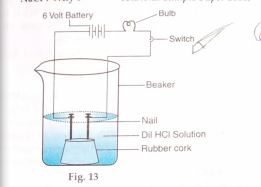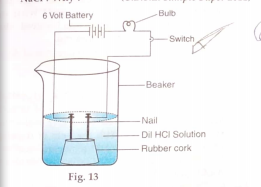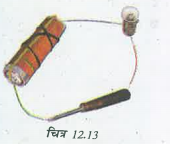An apparatus was set-up as shown in the figure. It was observed that when an aqueous solution of HCl was taken in the beaker and the circuit was closed the bulb in the circuit began to glow but it did not glow when the experiment was repeated with glucose solution. What could be the reason? Would the bulb glow if the same experiment is repeated with an aqueous solution of i NaOH ii NaCl? Why?
The bulb could glow when an aqueous solution of HCl was taken because HCl aq provided hydrogen and chloride H+ and Cl– ions which are carriers of electric charges in a solution while glucose being a covalent compound did not furnish any ions in the solution. i NaOH: The bulb will glow ii NaCl: The bulb will glow Because both of them being ionic compounds furnish ions in aqueous solutions.
Related Solutions
An appratus was set up as shown in the figure. It was observed that when an aqueous solution of HCl was taken in the beaker and the circit was closed, the bulb in the circuit began to glow, but it did not glow when the experiment was repeated with glucose solution. what could be the reason?
Would the bulb glow if the same experiment is repeated with an aqueous solution of
NaOH? why? View Solution
View SolutionAn appratus was set up as shown in the figure. It was observed that when an aqueous solution of HCl was taken in the beaker and the circit was closed, the bulb in the circuit began to glow, but it did not glow when the experiment was repeated with glucose solution. what could be the reason?
Would the bulb glow if the same experiment is repeated with an aqueous solution of
NaCl? why? View Solution
View SolutionRamesh took two beakers A and B full of two various solutions when connected them to an electric circuit. In beaker A the bulb glows, in beaker B bulb doesn't glow why ? What are the solution may be ?
View SolutionWould the bulb glow in the circuit shown in figure ?
View Solutionक्या चित्र में दिखाए गए परिपथ में बल्ब दीप्तिमान होगा?
View Solutionक्या चित्र में दिखाए गए परिपथ में बल्ब दीप्तिमान होगा?
View Solutionक्या चित्र में दिखाए गए परिपथ में बल्ब दीप्तिमान होगा?
 View Solution
View SolutionWould the bulb glow in the circuit shown in Fig. 12.15?
 View Solution
View SolutionA capacitor and an inductance coil are connected in separated AC circuits with a bulb glowing in both the circuits. The bulb glows more brightly when
View SolutionWill the bulb glow in the circuit shown below?
View SolutionPaheli set up an experiment using liquid A in the beaker as shown in Fig. 14.4. She observed that the bulb glows. Then she replaced the liquid A by another liquid B. This time the bulb did not glow. Boojho suggested replacing the bulb by an LED. They observed that the LED glows. Explain.
View SolutionWhen S, close bulb glows Instantaneously when closes there is a delay in glowing the bulb.
Explain the phenomenon self induction regarding above experiment
 View Solution
View SolutionIn the circuit diagram shown below :
What will be the order in which the bulbs A, B and C will glow when the switch is moved to the 'on' position ?
 View Solution
View SolutionIn the circuit shown in figure

(i) Would any of the bulbs glow when the switch is in the 'OFF' position?
(ii) What will be the order in which the bulbs A, B and C will glow when the switch is moved to the 'ON' position?View SolutionThe bulb glows only when ............. current is flowing in the circuit.
View SolutionIn a simple circuit, why does the bulb glow when you close the switch ?
View SolutionIn a simple circuit, why does the bulb glow when you close the switch ?
View SolutionIn a simple circuit, why does the bulb glow when you close the switch ?
View SolutionIdentifying the electric conductivity of a material:
Arrange an electric circuit with a battery and bulb. Close and circuit using an iron nail as shown in figure. Observe whether the bulb glows or not. Record your observations in table Repeat the same experiment using the other samplesa nd record your observation in the same table.
 View Solution
View SolutionIn which of these circuits will the bulb glow?
View Solution
